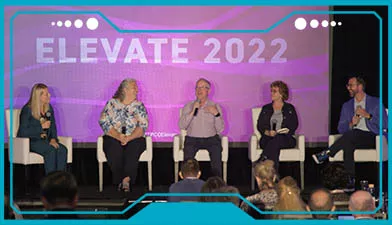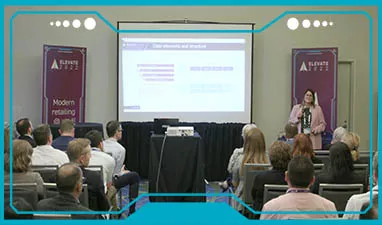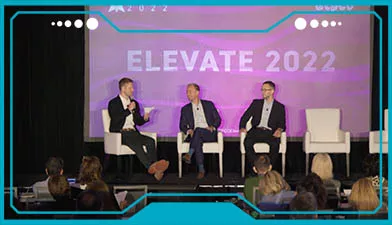On demand | Elevate 2022
A winning game: Consumer trust and dynamic offers
INTERVIEW • DYNAMIC OFFER CREATION
Many travelers may think dynamic offers only benefit airlines, but with more customized deals tailored to fit their needs, travelers can reap the benefits of dynamic offers, too!
Join us to learn how the industry can get to a trusted marketplace for consumers and how we can all become winners of the game.
Graham: Okay, good afternoon. I'm Graham Wareham, Director of Airline Strategy and Partnerships at ATPCO. I'm excited to be able to share a few minutes with you on stage here with a good friend of mine, Keith Wallace, Senior Director of Distribution and Payments at Air Canada. Keith's been in the business a long time.
Keith: Too long… gray hair.
Graham: He's been able to share with us lots of good insights in our offer content design councils as a primary industry partner. And Keith has been a tremendous supporter of ATPCO over the years and just happy to have you here to chat with me.
Keith: It's my pleasure to be here. Thanks for having me.
Graham: Well thanks for being had. So, it's not often that on a stage such as this, you guys put up with two Canadians.
Keith: Yeah, they don't know it. They don't know it.
Graham: So, I thought it would be appropriate to give Keith a little test.
Keith: What? I was a little nervous, given the title of this panel. My wife says I have trust issues. So… test?
Graham: We're just going to sort out whether he's truly a Canadian. Alright, so, I'm going to ask him a couple of questions he's going to know the answers and you guys are going to be sure he's Canadian. So, I'll start easy, I'll get hard, alright?
Keith: Oh no.
Graham: So, what's a Canadian's favorite letter?
Keith: A, eh.
Graham: How do you get 50 Canadians out of a swimming pool?
Keith: Well, the generally accepted answer to this question is you say “please,” and everybody gets out of the pool, but everyone knows that if it's all good friends in your pool you just tell them that you're down to one beer in the fridge and everyone's out of the pool right away.
Graham: So, what are the two seasons in Canada?
Keith: That's easy. Winter and July.
Graham: So far, he's doing perfect.
Keith: This is easy.
Graham: So, how do you get a Canadian to apologize?
Keith: You step on his foot.
Graham: Nice, yeah.
Keith: And he’ll apologize to you.
Graham: And here's the tough one: advanced Canadian here. Are you ready?
Keith: No.
Graham: Okay, so what do you do when you step on another Canadian's foot?
Keith: You apologize to them, then they apologize to you for making you apologize to them.
Graham: Yeah exactly.
Keith: Did I pass?
Graham: You passed! You are in the presence of Canadians. Right, so we don't have a lot of time. We have… well, they didn't start the clock yet.
Keith: That means we have all the time in the world!
Graham: They started the clock. Alright, so, we're here to talk about consumer trust and dynamic pricing. You guys have heard a lot about dynamic offers. Sorry, a lot about dynamic offers over the last the last few hours through presentations and a bit more tomorrow. So, we'll just get into it if that's all right with you?
Keith: Yeah, let's go!
Graham: So, maybe you can just tell me a bit about um Air Canada's path and journey on dynamic offers?
Keith: So, maybe the first thing I want to clear up is, for Air Canada at least, we think dynamic pricing and dynamic offers are two really different things and I think they get conflated in the industry a little bit. So, dynamic pricing is behind the curtain. Dynamic offers are in front of the curtain.
Dynamic pricing is a revenue management, a really important revenue management, strategy to try and get the price you offer to the customer as close to what you think the value of that seat is worth at any given point in time.
Dynamic offers is completely different. It is putting together a product offer for the customer to try and maximize the utility or the value of what they're spending with you.
So, our approach is definitely a revenue approach, but it's a revenue approach from a customer experience angle. We take a long-term view of this. We think that…
Look, as airlines start to enter more and more into the retailing space, and we start to get a bit more complex or a bit more depth than what we can offer a customer beyond just the price of a seat, we think that that choice can get complex and overwhelming. And you risk actually losing the customer instead of helping the customer.
So, we think that if you can actually put some intelligence behind what you put in front of the customer, try and help them kind of sort and filter out what is not valuable to them given what they're shopping for at any given point in time and put together some offers that are helpful to them, you can actually increase customer engagement and customer loyalty.
So, yes dynamic offers are a revenue positive strategy, but it's not at an individual—in our opinion—not at an individual transaction level. You're not trying to extract as much as you can out of the customer after that one purchase. You're trying to engage with them, make their experience with you positive, and, if you take a long view, you actually grow engagement and loyalty, and they come back and they buy from you again and again.
Graham: Good. Okay. This is it.
Keith: Perfect.
Graham: So, as you can see on the slide there, there was an article written in 2012. Keith or I just talked about this backstage that we can't believe it's 10 years ago that the discussion around dynamic started. So, a lot has changed in 10 years.
Keith: Yeah.
Graham: Maybe you can just tell us a bit about the progress you've made or the progressions you made and where you are?
Keith: It's been it's been a long journey, and look, I'll be honest with you, we're in some ways it kind of feels like we're still at the very beginning of this journey. If you're going to enter into being an offer-based airline, you need more than just fares and ticket prices.
You need to build up a catalog of things that you can put together to make an offer. And we've been, I was going to say slow, deliberate in in how we have been building that up.
And I'll tell you we're really only now kind of putting our toe into the water here, and this for a couple of reasons. We're taking maybe a very Canadian approach, very careful, and testing and learning and continually improving, but I would also say that I'm not convinced that all of the technology exists that an airline needs to do this well.
So, we're doing a couple of things. Look, I'll say, at least on aircanada.com, we're starting to test, given what the customer inputs and tells us in the shopping process, can we figure out maybe if this is a vacation purchase, a leisure shopper, a business shopper, and can we change the experience a little bit? Not really A/B testing, but just trying to figure out if we can help the customer through to find something that's a bit more targeted to what their intent is at that point in time, and we're doing we're actually making some good learning. We're getting pretty good telling if they're corporate or leisure, but it's really simple stuff.
The more important “what's going on right now” is, I would say, the biggest thing, the biggest realization or acceptance we made at the airline, is that true offer optimization is not one department's responsibility.
You're getting a mic.
Graham: Thank you.
Keith: We broke the lapels. So, I would tell you that we've put together a cross-department team that has the revenue management team in it, the revenue management science team in it, the IT group, the finance team, the digital e-commerce team, the distribution team, and we're trying to figure out what it looks like for Air Canada to be a true offer optimizing airline in two to three years. And we started with the easiest thing you can do: try and design kind of a reference IT architecture. What do we have and what do we need?
So, we think we have a pretty good blueprint about all the pieces that would need to come together for an airline to do, or at least for Air Canada to do this, and we've identified, “Hey, we have a couple of tools in place where this can fill that need,” and we have a lot of white spots or black spots where there's a gap. And now we're trying to figure out, “does this capability exist in the industry or do we need to partner with someone to build it?”, but it's going to be a two to three year kind of journey before we can get to a point where we really think we can understand what customers want and help them find the right experience from Air Canada on the day that they're shopping.
Graham: So, Air Canada has been, it's been a long journey, right. So, it was very early on in brands, it was very early on in API Direct. The relationships with the trade have been, I would say, always directionally positive, never punitive, but the trade, and having them engage through dynamic—channel specific—has always been a bit of a challenge, especially with your kind of products. Is this helpful?
Keith: What is it helpful? It probably makes the effort more complex, for sure. I'll tell you that as airlines, we probably have the easier job in this equation.
Customers who land on our website, on our mobile app, or talking to one of our contact center agents, it's probably pretty safe to assume they've made that first level final decision. They've chosen Air Canada. Now, we just have to help them find the right Air Canada product.
So, we can design an e-commerce experience or a mobile app experience or a contact center workflow to really key in on the Air Canada product, and get the customer out the door with something that matches what they were intending for their travel.
That's not true on the on the indirect side, on the travel agency side, on the aggregator side. This notion of comparison shopping comes in, right. And I'll freely admit that that is a daunting task for travel agents, or online, or brick and mortar for third-party aggregators to try and bring all this increased complexity from one airline together, with the increased complexity from 20 other airlines, and make it usable for the travel agent, for the customer, is really difficult.
But, look, I'm convinced that we're a brilliant industry. We've overcome bigger challenges than this. I'm convinced it's possible.
So, from the Air Canada side, I'll tell you maybe three things. We've invested super heavily in our NDC capabilities because we believe that we've got to get as much product information out to travel agencies hands so they can do that comparison. And this is not a discussion about GDS’s or travel agencies. This is a conversation about the technology that's been in place for a long time, just wasn't fit for purpose. We'll replace it and we'll replace it so that we can get all that rich product information out into the world for people to compare. And if they don't choose Air Canada… shame on us. We didn't do a good job about creating a product that resonates.
Two, we engage with third-party aggregators, travel agencies on a regular basis. We're happy to do it. We're glad to do it. We're eager to do it… to talk about the Air Canada product, to talk about what display you should look like, to try and help this conversation move along.
And then, maybe third, is great events like this that ATPCO runs or being out in the industry devoting not an insignificant amount of time and human resource to contributing to industry conversations to try and make this happen, because it's going to benefit all of us, for sure.
Graham: Yeah, so, you brought us to a few things. From this morning, we heard Alex talking about schedule-led or price-led, and as we get more and more into attributes, and more and more into consumers searching and looking for more and more clarity, how do you deal with consumer trust and that in this you know ever-changing world of complex choices?
Keith: So, look… I'll speak for Air Canada because it's the only thing I'm qualified to speak about. I'll say two things right off the bat. We are 100% not looking to take customer information and use it to make a decision about how much or how little we should charge for a given product. That is not a winning strategy, in my opinion. It is not our strategy.
The price for a product is the price for a product. We do revenue management up and down based upon demand and availability, but we do not take customer inputs to influence that. The price of a product is the price of a product.
Two, we think that with dynamic offers, we actually put more control into the customer's hands here. Think about it. Today, you know Air Canada, as you mentioned, fare brands. Air Canada has had fare brands for over a decade, even more probably, and it puts a really marginal level of choice in the hands of the customer. There’s four or five pre-bundled choices. You have to find one that is close to what you're looking for for a travel experience, but there's always that trade-off. You pay a little too much or you get a little less than you wanted. Maybe you can buy some ancillaries to add on to your experience, but it's not really control.
With dynamic offers, I think the dynamic part of it gets people a little worried. Dynamic offers means we're going to try and help you find the kind of experience you're looking to have, but we're not creating any walled gardens. We'll never say, “You can't have this product.” We will always create a safety valve for customers to be able to come back out, look at everything, and make a free choice about what they want to have.
So, I think the new world is only better for the customer because it puts more of the control in their hands, you know what I mean. We don't think the lowest price is the best price for everybody. We think that our job here is to help customers maximize the value they get out of the dollars they choose to spend. And getting them the lowest price, can actually do everyone harm, right.
Customer has a horrible experience. They don't come back and buy from me. The travel agent is stuck in the middle trying to explain why they didn't get the experience they're looking for. So, I think the new world is going to be way better if done right.
Graham: I think you're right. I think what you're talking about is matching customer demand with the offer. So, targeting. We've all had you know questionable experiences with targeted offers. How do you make sure you target the right offer to the right consumer?
Keith: Okay, we're not going to get it right. We’re not. At least at the beginning, we're not going to be really good at this. We're not a technology company. I think I said, I talked a bit about it earlier, where we're trying to learn from basic consumer inputs on our site, trying to figure out what kind of persona they have, but at the beginning, of this we're probably going to be pretty bad. Complete transparency.
So, that's why it's important, first of all like I said, we'll always have that safety valve for customers to get out of whatever path they've gone down, come back out, look at more things, and make a different choice. But, I would wager that, or I would at least propose, that not all customers come into the shopping experience knowing 100% what they want anyway, and might even change their mind while they're shopping.
So, I don't think we have to get it right. I think we can try and be helpful, try and suggest, try and understand, what the customer is looking for and direct them down a path. But, ultimately, the flexibility has to be on the consumer side so that they can move into a different product experience if that's what they want. Always.
Graham: Makes sense. So, not to be negative, but as we've all got back on the road a little bit, I do find myself walking through airports and stumbling over piles of lost baggage, or it's not really lost. Everyone knows where it is, it's just not…
Keith: I'm really sorry if we lost your bags. I'm really sorry.
Graham: So, do you see a world where dynamic offers helps you with operational issues?
Keith: Maybe, yeah. So, let me say, look, if the purchase becomes more intricate, with more parts, servicing it in a voluntary or involuntary change, gets more complicated for sure.
So, airlines, if they're going to do this, and we recognize this and we're doing it already, need to invest in tools, processes, staff training, to make sure that whatever the customer purchased, we can maintain the integrity of that purchase when they're voluntarily changing or when they're disrupted. There's a huge risk to get that wrong. So, it's got to be something you're aware of going into it.
Look, I'll tell you, it creates as much fear and anxiety in me as the next person. I never check a bag. A story at drinks I'll tell anybody about. I checked a bag at my wife's behest on the cruise, and now we're both on the same page. Never checking a bag.
So, I would say that the concept of one order, as terrifying as it is, is probably an important concept. Like this world that we're getting into, if we're going to enter into a world where we become retailers, we need to start having shopping cart mentalities. Having a PNR and an e-ticket and an END is ridiculous. So, as difficult as that change, as daunting as that change is, it's an important one if you're going to embrace offers and do it well. It's one thing.
Two, I actually think dynamic offers can be a great recovery tool. So, we unfortunately temporarily misplaced your bag the last time you traveled with us. We can offer you free checked baggage the next time you travel with us. So, although there are definitely failure points, the smart people say, “It's how you recover that makes all the difference,” and something like dynamic offers, if you are intelligent about it and you know what the customer wants, but also what happened to them the last few times they traveled with you, you can actually start regaining that trust almost immediately.
Graham: So, let me let's fast forward a little bit. So, imagine now we're a bit further ahead of ourselves and dynamic and you have everybody trying to interpret consumer demand, what I want what before or target me, and we all have different bundles and different offers… what happened to comparison shopping?
Keith: It's more difficult, but it's still there. Do you know what I mean? I think the thing here is that if we've all acknowledged that customers want a bit more control over their travel experience, right? They don't want… some people want the meal, and the in-flight entertainment, and the loyalty points. And some people don't. And making people pay for something they don't want, or not giving people the opportunity to buy something all-included when that's what they want, is doing a disservice to everybody.
So, I think we all need to acknowledge the world is going to get more complex, but it is absolutely possible to help customers. If you put the right information from the customer, if you provide a flexible shopping experience, customers will find their way through it. They'll pick two or three or four things that they want from their experience, they'll tell us or their travel agent, and we'll create an offer for them. We'll get there. This is not an insurmountable problem.
Graham: Yeah, I think you're right. So, anyways, we're coming to time, it looks like. I think we have several more questions, but we'll have to…
Keith: The next panel where they let two Canadians.
Graham: The next panel with two Canadians. So, for those of you who see Keith around tonight, there's two words you need to know, and that's “boat race.” He'll know what that means if you don't… it's an interesting experience, challenging a Canadian to a boat race.
Keith: It is.
Graham: I dare you.
Keith: I'm up for it.
Graham: Thanks a lot for spending the time with us. It's been very informative telling us about dynamic offers. Thanks so much.
Keith: That was a lot of fun, thanks.
An event experience you can't miss
ATPCO's Elevate + ARC's TravelConnect
Speakers

Keith Wallis
Senior Director, Distribution and Payments , Air Canada
Keith has 25 years of experience in the airline industry. At Air Canada, he works to maximize revenue performance and cost efficiency through the development of a global distribution and payments strategy, business development activities, and account management. He is responsible for the carrier’s joint distribution strategy within Star Alliance. Keith serves on the Board of Directors of UATP, chairs IATA’s Distribution Advisory Council, and represents Air Canada on the IATA Shop-Order Services Board. He is also the Business Chair of the ATPCO Offer Content Council. Keith holds a bachelor’s degree from UNB and an MBA from McGill University, and is a certified Six Sigma Black Belt.

Graham Wareham
Director, Business Development and Partnerships , ATPCO
Graham has over 20 years of experience in the airline industry, including more than five years with ATPCO. His most recent experience as an aviation executive included strategic development, cost/revenue management, and market analysis. Before joining ATPCO, Graham worked as a Senior Director, Distribution and Consumer Direct for Air Canada. In his current role, Graham leads ATPCO's Business Development and Industry team, developing strategic business partnerships and relationships that will help to evolve standards and solutions that help solve evolving industry issues.
You might also like



